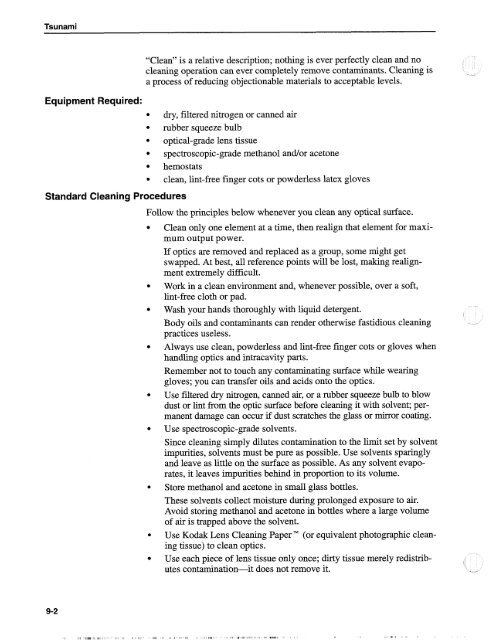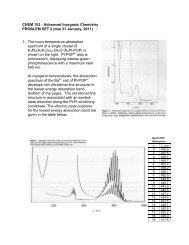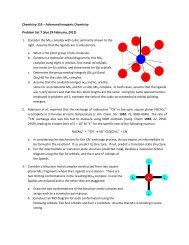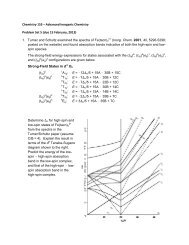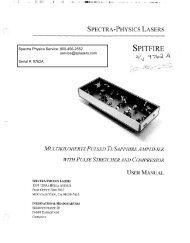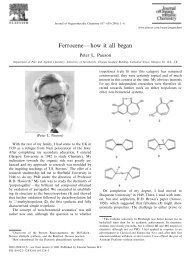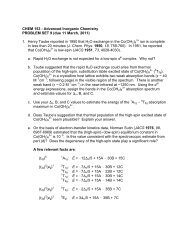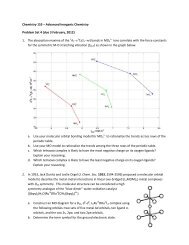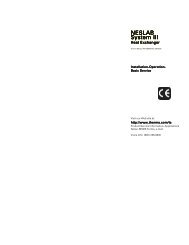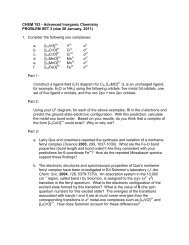Tsunami - Beckman Institute Laser Resource Center
Tsunami - Beckman Institute Laser Resource Center
Tsunami - Beckman Institute Laser Resource Center
You also want an ePaper? Increase the reach of your titles
YUMPU automatically turns print PDFs into web optimized ePapers that Google loves.
<strong>Tsunami</strong><br />
"Clean" is a relative description; nothing is ever perfectly clean and no<br />
cleaning operation can ever completely remove contaminants. Cleaning is -<br />
a process of reducing objectionable materials to acceptable levels.<br />
Equipment Required:<br />
Standard Cleaning Procedures<br />
dry, filtered nitrogen or canned air<br />
rubber squeeze bulb<br />
optical-grade lens tissue<br />
spectroscopic-grade methanol andlor acetone<br />
hemostats<br />
clean, lint-free finger cots or powderless latex gloves<br />
Follow the principles below whenever you clean any optical surface.<br />
Clean only one element at a time, then realign that element for maximum<br />
output power.<br />
If optics are removed and replaced as a group, some might get<br />
swapped. At best, all reference points will be lost, making realignment<br />
extremely difficult.<br />
Work in a clean environment and, whenever possible, over a soft,<br />
lint-free cloth or pad.<br />
Wash your hands thoroughly with liquid detergent.<br />
Body oils and contaminants can render otherwise fastidious cleaning<br />
practices useless.<br />
Always use clean, powderless and lint-free finger cots or gloves when<br />
handling optics and intracavity parts.<br />
Remember not to touch any contaminating surface while wearing<br />
gloves; you can transfer oils and acids onto the optics.<br />
Use filtered dry nitrogen, canned air, or a rubber squeeze bulb to blow<br />
dust or lint from the optic surface before cleaning it with solvent; permanent<br />
damage can occur if dust scratches the glass or mirror coating.<br />
Use spectroscopic-grade solvents.<br />
Since cleaning simply dilutes contamination to the limit set by solvent<br />
impurities, solvents must be pure as possible. Use solvents sparingly<br />
and leave as little on the surface as possible. As any solvent evaporates,<br />
it leaves impurities behind in proportion to its volume.<br />
Store methanol and acetone in small glass bottles.<br />
These solvents collect moisture during prolonged exposure to air.<br />
Avoid storing methanol and acetone in bottles where a large volume<br />
of air is trapped above the solvent.<br />
Use Kodak Lens Cleaning Paper" (or equivalent photographic cleaning<br />
tissue) to clean optics.<br />
Use each piece of lens tissue only once; dirty tissue merely redistributes<br />
contamination-it does not remove it.<br />
I<br />
'I<br />
-*


